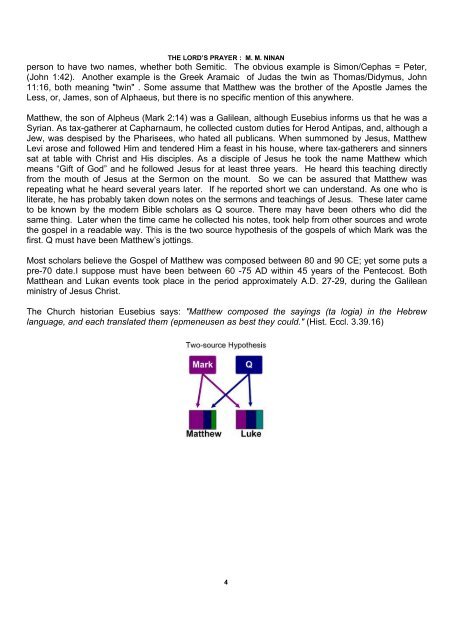Lord's Prayer
Create successful ePaper yourself
Turn your PDF publications into a flip-book with our unique Google optimized e-Paper software.
THE LORD’S PRAYER : M. M. NINAN<br />
person to have two names, whether both Semitic. The obvious example is Simon/Cephas = Peter,<br />
(John 1:42). Another example is the Greek Aramaic of Judas the twin as Thomas/Didymus, John<br />
11:16, both meaning "twin" . Some assume that Matthew was the brother of the Apostle James the<br />
Less, or, James, son of Alphaeus, but there is no specific mention of this anywhere.<br />
Matthew, the son of Alpheus (Mark 2:14) was a Galilean, although Eusebius informs us that he was a<br />
Syrian. As tax-gatherer at Capharnaum, he collected custom duties for Herod Antipas, and, although a<br />
Jew, was despised by the Pharisees, who hated all publicans. When summoned by Jesus, Matthew<br />
Levi arose and followed Him and tendered Him a feast in his house, where tax-gatherers and sinners<br />
sat at table with Christ and His disciples. As a disciple of Jesus he took the name Matthew which<br />
means “Gift of God” and he followed Jesus for at least three years. He heard this teaching directly<br />
from the mouth of Jesus at the Sermon on the mount. So we can be assured that Matthew was<br />
repeating what he heard several years later. If he reported short we can understand. As one who is<br />
literate, he has probably taken down notes on the sermons and teachings of Jesus. These later came<br />
to be known by the modern Bible scholars as Q source. There may have been others who did the<br />
same thing. Later when the time came he collected his notes, took help from other sources and wrote<br />
the gospel in a readable way. This is the two source hypothesis of the gospels of which Mark was the<br />
first. Q must have been Matthew’s jottings.<br />
Most scholars believe the Gospel of Matthew was composed between 80 and 90 CE; yet some puts a<br />
pre-70 date.I suppose must have been between 60 -75 AD within 45 years of the Pentecost. Both<br />
Matthean and Lukan events took place in the period approximately A.D. 27-29, during the Galilean<br />
ministry of Jesus Christ.<br />
The Church historian Eusebius says: "Matthew composed the sayings (ta logia) in the Hebrew<br />
language, and each translated them (epmeneusen as best they could." (Hist. Eccl. 3.39.16)<br />
4


















